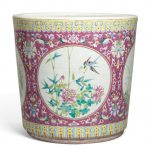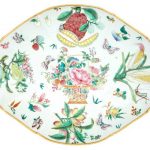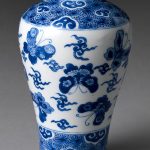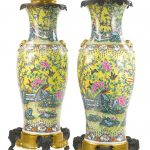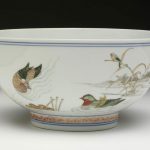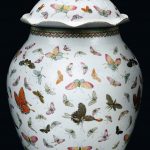Chinese Porcelain. Porcelain was invented in China over a centuries-long development period beginning with “proto-porcelain” wares dating from the Shang dynasty (1600–1046 BC). By the time of the Eastern Han dynasty (AD 25–220) these early glazed ceramic wares had developed into porcelain, which Chinese defined as high-fired ware. Reference: Chinese Porcelain: Art, Elegance and Appreciation (Arts of China) By the late Sui dynasty (581–618 AD) and early Tang dynasty (618–907 AD), the now-standard requirements of whiteness and translucency had been achieved, in types such as Ding ware. The wares were already exported to the Islamic world, where they were highly prized.
Eventually, porcelain and the expertise required to create it began to spread into other areas of East Asia. During the Song dynasty (960–1279 AD), artistry and production had reached new heights. The manufacture of porcelain became highly organised, and the dragon kilns excavated from this period could fire as many as 25,000 pieces at a time, and over 100,000 by the end of the period. While Xing ware is regarded as among the greatest of the Tang dynasty porcelain, Ding ware became the premier porcelain of the Song dynasty.
By the time of the Ming dynasty (1368–1644 AD), porcelain wares were being exported to Europe. Some of the most well-known Chinese porcelain art styles arrived in Europe during this era, such as the coveted “blue-and-white” wares. The Ming dynasty controlled much of the porcelain trade, which was expanded to Asia, Africa and Europe via the Silk Road. In 1517, Portuguese merchants began direct trade by sea with the Ming dynasty, and in 1598, Dutch merchants followed.
Some porcelains were more highly valued than others in imperial China. The most valued types can be identified by their association with the court, either as tribute offerings, or as products of kilns under imperial supervision. Since the Yuan dynasty, the largest and best centre of production has made Jingdezhen porcelain. During the Ming dynasty, Jingdezhen porcelain become a source of imperial pride. The Yongle emperor erected a white porcelain brick-faced pagoda at Nanjing, and an exceptionally smoothly glazed type of white porcelain is peculiar to his reign. Jingdezhen porcelain’s fame came to a peak during the Qing dynasty. Reference: Wikipedia
A LARGE ENAMELED PORCELAIN PLANTER Republic period The flared cylindrical vessel decorated with four medallions of chrysanthemums, grasses, peonies and iris growing in clusters near insects, butterflies and birds, reserved on a purple sgraffito ground enameled with fronted lotus and peaches set between borders of ruyi heads and stiff lappets, wear. 15 1/2in (39.4cm) high; 15 3/8in (39cm) diam
Sold for US$ 765 (£ 613) inc. premium at Bonham’s in 2019
A MAGNIFICENT PAIR OF FAMILLE ROSE ‘BUTTERFLY’ DOUBLE-GOURD VASES QIANLONG SIX-CHARACTER SEAL MARKS IN UNDERGLAZE BLUE AND OF THE PERIOD (1736-1795) Each vase is elaborately decorated to the bulbous lower section with butterflies of various sizes and colours flying amidst leafy floral sprays including peony, chrysanthemum, morning glory, rose and aster, above a band of pink lotus petals. The shoulder is encircled by a ruyi border and bands of floral sprays, below the upper section which is enamelled with further butterflies and flower heads. The mouth rim is decorated with an iron-red key-fret border, and the pair of handles are adorned with stylised foliate designs. 9 in. (23 cm.) high
Sold for GBP 14,725,000 at Christie’s in 2017
Chinese Famille Rose Enamel-Decorated and Parcel-Gilt Porcelain Footed Dish First half 19th century Of shaped form, decorated with ears of corn, fruit, plants, flowers, butterflies and insects and centered by a basket of flowers, on a shaped foot. Height 4 inches (10.2 cm), width 15 1/2 inches (30.4 cm).
Sold for $1,125 (includes buyer’s premium) at Doyle in 2020
Vase with Butterflies late 17th–early 18th century China The Chinese term for butterfly (hudie) is also a rebus for the accumulation of blessings.
Qing dynasty (1644–1911), Kangxi period (1662–1722)
Reference: The Metropolitan Museum of Art
A large pair of Chinoiserie gilt and patinated bronze mounted Chinese export porcelain vases, mounted as oil lamps France, late 19th/early 20th century the vases decorated in the round with phoenix birds, roosters, butterflies, and peacocks amongst a lavish garden scene raised on tripod elephant head supports height 35 1/2 in. 90 cm
Sold for 25,000 USD at Sotheby’s in 2013
Porcelain bowl painted with enamel colours depicting lotuses, bamboo, water, ducks and other birds. Inside, painted with small red flowers and two butterflies.
In the early 1680s the colour palette of enamels was expanded and perfected with the addition of a new translucent green. Porcelain decorated in this new palette of either green, blue, red, yellow, aubergine, brown and black enamels is known as yingcai in Chinese (strong colours) or wucai (five colours). Within Europe the palette acquired the name famille verte to reflect the predominance of green in the designs. On this vase, the combined motifs of mandarin ducks with lotus plants was particularly auspicious and symbolised a harmonious marriage and many sons.
Reference: © Victoria and Albert Museum

